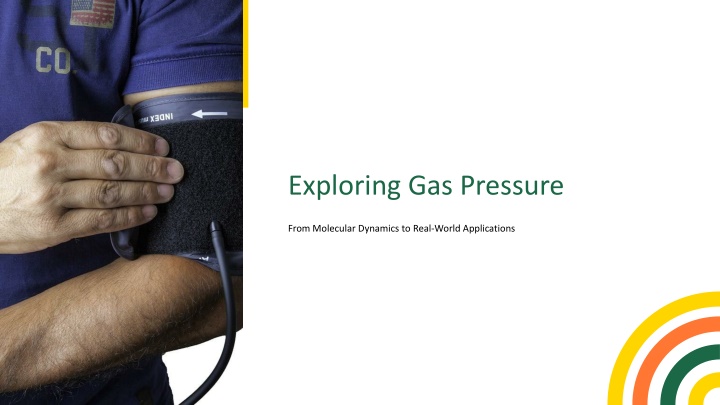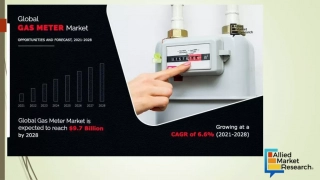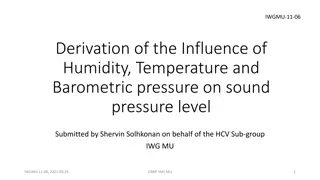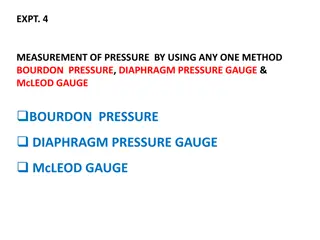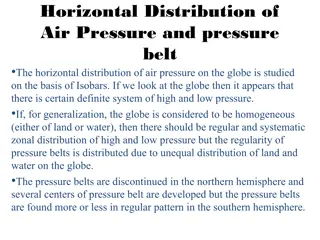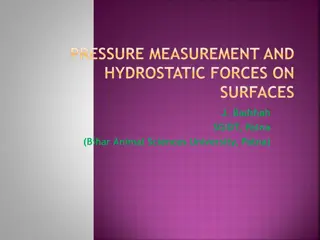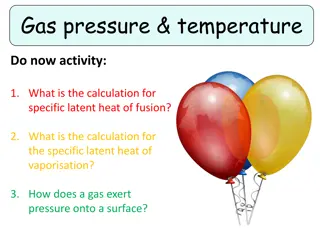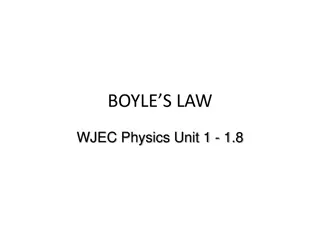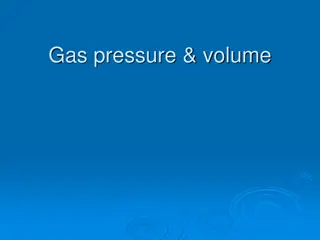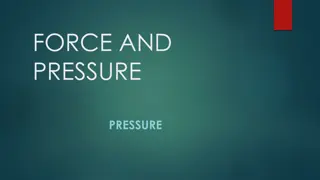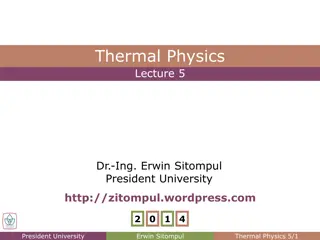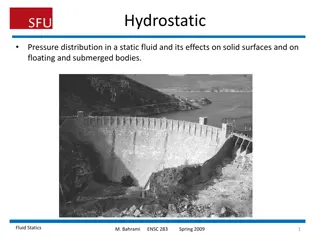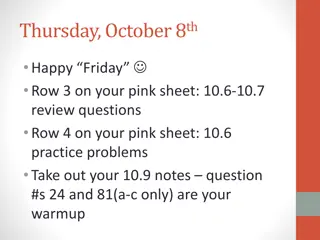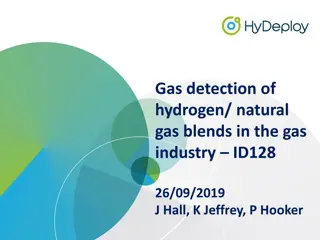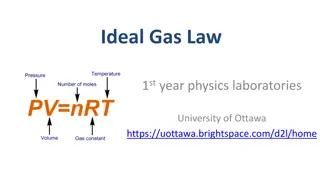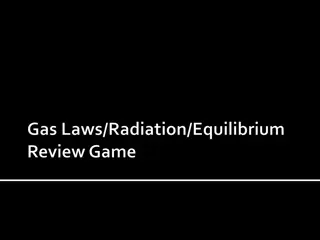Gas Pressure: Molecular Dynamics to Real-World Applications
Gas pressure, an invisible force impacting our daily lives, is explored from molecular dynamics to real-world applications. Understand how gas molecules create pressure through motion and collisions, affecting diverse areas such as weather systems, scuba diving, hot air balloons, space exploration, human health, climate change, industrial processes, energy production, and environmental impact. Discover the significance of gas pressure in atmospheric composition and material science.
Download Presentation

Please find below an Image/Link to download the presentation.
The content on the website is provided AS IS for your information and personal use only. It may not be sold, licensed, or shared on other websites without obtaining consent from the author.If you encounter any issues during the download, it is possible that the publisher has removed the file from their server.
You are allowed to download the files provided on this website for personal or commercial use, subject to the condition that they are used lawfully. All files are the property of their respective owners.
The content on the website is provided AS IS for your information and personal use only. It may not be sold, licensed, or shared on other websites without obtaining consent from the author.
E N D
Presentation Transcript
Exploring Gas Pressure From Molecular Dynamics to Real-World Applications
Table of contents 01 Lesson Introduction 02 Subject Knowledge: Molecular Dynamics of Gas Pressure 03 Subject Knowledge: Impact of Gas Pressure on Everyday Life 04 Hands-On Experiments: Demonstrating Gas Pressure 05 Gas Laws: Boyle's Law 06 Gas Laws: Charles's Law 07 Gas Laws: Avogadro's Law 08 Gas Laws: Combined Gas Law 09 Real-World Applications of Gas Pressure 10 Gas Pressure in Weather Systems 11 Gas Pressure in Scuba Diving
Table of contents 12 Gas Pressure in Hot Air Balloons 13 Gas Pressure in Space Exploration 14 Gas Pressure and Human Health 15 Gas Pressure and Climate Change 16 Gas Pressure and Industrial Processes 17 Gas Pressure and Energy Production 18 Gas Pressure and Environmental Impact 19 Gas Pressure and Atmospheric Composition 20 Gas Pressure and Material Science
1 Lesson Introduction Lesson Introduction Gas pressure is an incredible and invisible force that surrounds us every moment of our moment of our lives! Imagine a world where invisible molecules are constantly bouncing around, creating pressure that impacts everything from our breathing to how balloons float and how aeroplanes fly. This lesson will transform students' understanding of how gases behave, revealing the hidden scientific principles that govern the world around them. We'll explore how tiny molecular movements create powerful forces that shape our environment, making physics come alive through exciting experiments and hands-on learning. Exploring Gas Pressure
2 Subject Knowledge: Molecular Dynamics of Gas Pressure 03 01 02 04 05 Impact of Molecular Collisions Speed of Molecular Movement Relationship to Temperature Gas Molecules in Motion Motion Pressure Equilibrium The kinetic energy of gas molecules, Gas pressure is a result of the In a closed container, gas pressure When gas molecules collide with Gas molecules move at incredibly which determines their speed and continuous, rapid movement of gas reaches equilibrium when the rate with the walls of the container, incredibly high speeds, with therefore the pressure they exert, is molecules within a confined space. of molecules colliding with the container, they exert a force that velocities ranging from hundreds directly proportional to the walls equals the rate of molecules that contributes to the overall gas hundreds to thousands of meters These molecules move in all temperature of the gas. bouncing off the walls. gas pressure. meters per second. directions, colliding with each other As temperature increases, so does the and the walls of the container. This balance maintains a constant The more frequent and energetic This rapid motion generates the average speed of the molecules, pressure within the system. the collisions, the higher the force that we perceive as gas leading to higher pressure. pressure. pressure. Exploring Gas Pressure
3 Subject Knowledge: Impact of Gas Pressure on Everyday Life 02 04 01 03 Molecular Dynamics of Gas Pressure Breathing Process Aerodynamics in Flight Balloons and Buoyancy Gas pressure plays a crucial role in the process of breathing. Gas pressure is created by the continuous random movement of Gas pressure is fundamental in the field of aerodynamics, The concept of gas pressure is evident in how balloons breathing. movement of gas molecules within a contained space. influencing how airplanes fly. balloons float. When we inhale, the diaphragm contracts, creating a lower These microscopic particles are in constant motion, colliding with By manipulating air pressure above and below the wings, Filling a balloon with a gas lighter than air, such as helium, pressure in the lungs compared to the atmosphere, causing air to container walls and each other at incredible speeds. aircraft can generate lift. causes it to rise. rush in. Each collision exerts a force on the walls, contributing to the Understanding and controlling gas pressure allows planes to This showcases how gas pressure can defy gravity and lift When we exhale, the diaphragm relaxes, increasing the pressure in overall pressure of the gas. defy gravity and soar through the skies efficiently. objects. the lungs, pushing air out. Exploring Gas Pressure
4 Hands-On Experiments: Demonstrating Gas Pressure 01 03 02 04 05 Introduction to Gas Pressure Experiment Setup Balloon Inflation Syringe Compression Marshmallow Challenge Gas pressure is a result of the Set up a closed container with a Inflate a balloon and observe Use a syringe to compress air Place a marshmallow in a the continuous random with a pressure gauge to observe how the pressure and demonstrate how the vacuum chamber and observe movement of gas molecules measure the gas pressure inside the balloon increases as pressure increases as the how it expands due to the molecules within a confined inside. as more air is pumped in. volume decreases. decrease in external pressure. confined space. Exploring Gas Pressure
5 Gas Laws: Boyle's Law pressure dynamics. Understanding Boyle's Law Boyle's Law states that the pressure of a gas is inversely proportional to its volume when temperature is kept constant. Real-World Examples Examples of Boyle's Law in action include inflating a bicycle tire, using a syringe to administer medication, and understanding the compression of gases in a car engine. Mathematical Representation The mathematical expression for Boyle's Law is: P1V1 = P2V2, where P represents pressure and V represents volume. Practical Implications Boyle's Law helps us understand how changes in volume affect gas pressure, crucial in various applications like scuba diving, weather forecasting, and even in medical devices. Experimental Verification Students can conduct experiments using syringes and pressure gauges to observe Boyle's Law in action, reinforcing their understanding of gas Exploring Gas Pressure
6 Gas Laws: Charles's Law 01 02 03 Molecular Dynamics of Gas Pressure Pressure Charles's Law Practical Applications Understanding Charles's Law is crucial in various real-world Charles's Law states that, at constant pressure, the volume of a gas Gas pressure is created by the continuous random movement of applications. of a gas is directly proportional to its absolute temperature. movement of gas molecules within a contained space. temperature. In weather balloons, changes in temperature affect the volume of the These microscopic particles are in constant motion, colliding with gas inside the balloon, causing it to expand or contract. As the temperature of a gas increases, so does its volume, and vice container walls and each other at incredible speeds. versa. This principle is fundamental in industries like manufacturing and Each collision imparts a force on the walls, contributing to the healthcare, where precise control of gas volumes is essential. Mathematically, Charles's Law can be expressed as: V1/T1 = V2/T2. overall pressure exerted by the gas. Exploring Gas Pressure
7 Gas Laws: Avogadro's Law STRENTHS WEAKNESSES Avogadro's Law provides a fundamental understanding of the relationship between the volume of a gas and the number of molecules present. Avogadro's Law assumes ideal gas behavior, which may not always always hold true in real-world scenarios. It does not account for intermolecular forces or molecular size, limiting its applicability in certain situations. It helps in explaining the behavior of gases under different conditions, leading to the development of various gas laws. W S The law may be challenging to comprehend for individuals without a strong background in chemistry or physics. Avogadro's Law is crucial in chemical reactions involving gases, aiding in stoichiometry calculations. OPPORTUNITIES THREATS T O Further research and experimentation can enhance our understanding of gas behavior and potentially lead to refinements or extensions of Avogadro's Law. Misinterpretation or misapplication of Avogadro's Law can result in result in errors in scientific calculations and experimental outcomes. outcomes. Applications of Avogadro's Law in industries such as manufacturing, pharmaceuticals, and environmental science offer opportunities for innovation and problem-solving. Failure to consider deviations from ideal gas behavior can lead to inaccuracies in practical applications of the law. Lack of awareness or understanding of Avogadro's Law among professionals in relevant fields may hinder its effective utilization in various industries. Education initiatives can focus on simplifying the concepts behind Avogadro's Law to make it more accessible to a wider audience. Exploring Gas Pressure
8 Gas Laws: Combined Gas Law 02 04 01 03 Molecular Dynamics of Gas Pressure Impact on the Environment Hands-On Learning Understanding Gas Pressure The pressure of gases impacts various aspects of Gas pressure is a result of microscopic particles in Gas pressure is an incredible and invisible force Through exciting experiments and hands- aspects of our environment, from our breathing to particles in constant motion, colliding with that surrounds us every moment of our lives. on activities, students can witness firsthand breathing to the behavior of objects like balloons container walls and each other at incredible how gas pressure behaves and learn about It is created by the continuous random balloons and airplanes. speeds. the scientific principles that govern this movement of gas molecules within a contained Understanding gas pressure is crucial in explaining These collisions create the pressure that we space. phenomenon. these phenomena. experience. Exploring Gas Pressure
9 Real-World Applications of Gas Pressure Pressure Scuba Diving Weather Forecasting 01 02 Gas pressure plays a crucial role in determining determining weather patterns. In scuba diving, understanding gas pressure is is essential for divers' safety. Meteorologists use changes in atmospheric pressure to predict upcoming weather conditions, such as the likelihood of storms or clear skies. As divers descend underwater, the pressure increases, affecting the amount of compressed air they breathe and the buoyancy of their equipment. Food Packaging Medical Equipment 03 04 Gas pressure is utilized in food packaging to extend extend the shelf life of products. Various medical devices, such as ventilators and and anesthesia machines, rely on gas pressure to pressure to deliver precise amounts of oxygen or oxygen or anesthesia to patients. By adjusting the gas composition and pressure inside packaging, manufacturers can preserve freshness and prevent spoilage. Understanding gas pressure is critical for maintaining proper functionality and patient care. Exploring Gas Pressure
10 Gas Pressure in Weather Systems STRENTHS WEAKNESSES Gas pressure plays a crucial role in the formation and movement of weather systems. Sudden changes in gas pressure can lead to unpredictable weather events. Understanding gas pressure helps meteorologists predict and track weather patterns accurately. Inaccurate measurements of gas pressure can impact weather forecasting reliability. W S OPPORTUNITIES THREATS T O Advancements in technology allow for more precise monitoring and monitoring and analysis of gas pressure in weather systems. Climate change may alter atmospheric gas pressure patterns, patterns, affecting global weather systems. Research on gas pressure variations can lead to improved early warning systems for severe weather conditions. Lack of public awareness about the importance of gas pressure in weather forecasting can hinder disaster preparedness efforts. Exploring Gas Pressure
11 Gas Pressure in Scuba Diving STRENTHS WEAKNESSES Enables divers to breathe underwater by providing compressed air at compressed air at high pressure. Incorrectly calibrated gas pressure can lead to equipment malfunctions and pose risks to divers. Allows for safe exploration of underwater environments, enhancing the diving experience. Limited air supply can restrict dive time, requiring careful monitoring and planning. W S Regulated gas pressure ensures a controlled breathing rate for divers, promoting safety. Rapid changes in gas pressure during ascent and descent can cause decompression sickness if not managed properly. OPPORTUNITIES THREATS T O Advancements in technology can lead to improved gas pressure pressure regulators and monitoring systems. Ignoring gas pressure safety protocols can result in serious injuries or injuries or fatalities for divers. Training programs can educate divers on proper gas pressure management techniques for enhanced safety. Environmental factors such as temperature and depth can impact gas pressure levels, requiring adaptation. Collaboration with medical professionals can help develop better understanding and treatment of gas pressure-related health issues in diving. Inadequate maintenance of diving equipment can lead to gas pressure failures, endangering divers' lives. Exploring Gas Pressure
12 Gas Pressure in Hot Air Balloons STRENTHS WEAKNESSES Provides a clear understanding of gas pressure dynamics May be too detailed for beginners Highlights the role of molecular motion in pressure creation Requires prior knowledge of molecular physics W S OPPORTUNITIES THREATS T O Complexity may deter some learners Can be used to explain real-world applications like hot air balloons balloons Misunderstanding of concepts could lead to confusion Potential for interactive demonstrations Exploring Gas Pressure
13 Gas Pressure in Space Exploration Importance of Gas Pressure in Space Exploration Molecular Dynamics of Gas Pressure 01 02 In the vacuum of space, where there is no atmosphere, maintaining gas pressure is crucial for human survival. Gas pressure is created by the continuous random random movement of gas molecules within a contained contained space. Spacesuits and spacecraft are designed to provide a controlled environment with the necessary pressure to support life functions. These microscopic particles are in constant motion, colliding with container walls and each other at incredible speeds. Understanding gas pressure is essential for ensuring the safety and success of space missions. Each collision imparts a force on the walls, contributing to the overall pressure exerted by the gas. Challenges of Gas Pressure in Space Space 03 Spacecraft must withstand extreme changes in pressure pressure during launch and re-entry into Earth's atmosphere. Engineers must carefully calculate and regulate internal gas pressure to prevent structural damage and ensure the well-being of astronauts. The delicate balance of gas pressure management is a critical aspect of space exploration technology. Exploring Gas Pressure
14 Gas Pressure and Human Health STRENTHS WEAKNESSES Understanding gas pressure can help in the development of medical devices like respirators and oxygen tanks. Lack of knowledge about gas pressure can lead to accidents in high- pressure environments. Proper understanding of gas pressure is crucial in scuba diving to prevent decompression sickness. Mismanagement of gas pressure in medical settings can have severe consequences for patients. W S Gas pressure plays a vital role in the functioning of the human respiratory system. Ignorance of gas pressure principles can result in improper ventilation systems in buildings, affecting indoor air quality. OPPORTUNITIES THREATS T O Research in gas pressure can lead to advancements in treating treating respiratory diseases. Inadequate maintenance of gas pressure equipment can pose risks to pose risks to both human health and the environment. Education on gas pressure can improve workplace safety in industries dealing with compressed gases. Incorrect handling of gas pressure systems can lead to explosions or leaks with harmful consequences. Understanding gas pressure can enhance emergency response protocols for incidents involving gas leaks. Lack of awareness about gas pressure in healthcare settings can result in medical errors and compromised patient safety. Exploring Gas Pressure
15 Gas Pressure and Climate Change Greenhouse Gases and Atmospheric Pressure Molecular Dynamics of Gas Pressure 01 02 Gas pressure is created by the continuous random random movement of gas molecules within a contained space. Greenhouse gases, such as carbon dioxide and and methane, play a crucial role in regulating regulating Earth's temperature by trapping heat in heat in the atmosphere. These microscopic particles are in constant motion, colliding with container walls and each other at incredible speeds. Increased levels of these gases lead to higher atmospheric pressure, contributing to global warming and climate change. Each collision exerts a force on the walls, contributing to the overall pressure of the gas. Impact on Weather Patterns Human Activities and Gas Emissions 03 04 Changes in gas pressure, particularly in the atmosphere, can influence weather patterns and and lead to extreme events like hurricanes, droughts, and heatwaves. Human activities, such as burning fossil fuels and and deforestation, release large amounts of greenhouse gases into the atmosphere. These activities intensify the greenhouse effect and alter global gas pressure systems. Understanding these pressure dynamics is essential for predicting and mitigating the effects of climate change. Addressing these emissions is critical in combating climate change. Exploring Gas Pressure
16 Gas Pressure and Industrial Processes STRENTHS WEAKNESSES Gas pressure plays a crucial role in various industrial processes, such as manufacturing, chemical reactions, and power generation. Inadequate control or understanding of gas pressure can result in safety hazards, such as leaks, explosions, or equipment failure. Understanding gas pressure allows for the optimization of processes, leading to increased efficiency and productivity. Fluctuations in gas pressure can disrupt production processes and lead to product quality issues. W S Industrial applications of gas pressure include pneumatic systems, pressurized storage, and gas compression for energy production. Maintenance and monitoring of gas pressure systems require specialized knowledge and resources. OPPORTUNITIES THREATS T O Advancements in technology offer opportunities for the development of development of more efficient and sustainable industrial processes utilizing processes utilizing gas pressure. Environmental concerns related to gas pressure systems, such as such as greenhouse gas emissions and energy consumption, pose pose regulatory and reputational risks for industries. Training programs and educational initiatives can enhance understanding of gas pressure among industrial workers, leading to improved safety and performance. Global economic fluctuations and market demands can impact the utilization of gas pressure technologies in industrial sectors. Rapid changes in regulations and standards regarding gas pressure management may require industries to adapt quickly to remain compliant and competitive. Collaboration with experts in the field of gas pressure can drive innovation and the discovery of new applications in various industries. Exploring Gas Pressure
17 Gas Pressure and Energy Production STRENTHS WEAKNESSES Gas pressure is a fundamental concept in energy production processes. Inadequate control or understanding of gas pressure can lead to lead to inefficiencies in energy production. Understanding gas pressure allows for efficient utilization of resources in energy generation. Fluctuations in gas pressure can impact the stability and reliability of energy generation systems. W S Gas pressure plays a crucial role in various energy production methods such as combustion and steam generation. Lack of proper maintenance of pressure systems can result in safety hazards and operational disruptions. OPPORTUNITIES THREATS T O Advancements in technology offer opportunities to optimize gas optimize gas pressure systems for enhanced energy production. production. External factors such as natural disasters or accidents can disrupt gas disrupt gas pressure systems, affecting energy production. Inadequate regulations or compliance standards regarding gas pressure in energy facilities pose risks to both the environment and human safety. Research and development in gas pressure management can lead to more sustainable and eco-friendly energy solutions. Collaboration with experts in the field can provide insights into innovative ways to harness gas pressure for energy production. Dependence on fossil fuels for energy production, which involves managing gas pressure, contributes to environmental challenges such as climate change. Exploring Gas Pressure
18 Gas Pressure and Environmental Impact STRENTHS WEAKNESSES Gas pressure plays a crucial role in various natural processes, such as processes, such as the water cycle and atmospheric circulation. circulation. Human activities, such as burning fossil fuels, can lead to an increase increase in greenhouse gases, affecting atmospheric pressure and pressure and contributing to climate change. Understanding gas pressure helps in predicting weather patterns and atmospheric phenomena. Changes in gas pressure due to pollution can have detrimental effects on air quality and human health. W S Gas pressure is essential for maintaining the balance of gases in the atmosphere, contributing to Earth's habitability. Industrial processes releasing gases under high pressure can lead to environmental hazards if not properly managed. OPPORTUNITIES THREATS T O Continued disregard for environmental regulations and unsustainable unsustainable practices can exacerbate the negative effects of gas pressure pressure on the environment. Advancements in technology can help monitor and regulate gas gas pressure levels to mitigate environmental impacts. Education and awareness programs can promote sustainable practices to reduce the negative effects of gas pressure on the environment. Natural disasters, such as volcanic eruptions or wildfires, can release large amounts of gases into the atmosphere, impacting gas pressure levels. Climate change resulting from alterations in gas pressure dynamics poses a significant threat to ecosystems, biodiversity, and human well-being. Research into alternative energy sources can help reduce reliance on fossil fuels and minimize the impact of gas pressure changes on the environment. Exploring Gas Pressure
19 Gas Pressure and Atmospheric Composition STRENTHS WEAKNESSES Gas pressure is a fundamental concept in physics, essential for for understanding various natural phenomena. The abstract nature of gas pressure can be challenging for some some students to grasp initially. Hands-on experiments can vividly demonstrate the effects of gas pressure, enhancing student engagement. Safety precautions are necessary when conducting experiments involving high-pressure gases. W S Gas pressure plays a crucial role in everyday life, from weather patterns to scuba diving. The mathematical calculations involved in quantifying gas pressure can be complex for younger learners. OPPORTUNITIES THREATS T O Exploring real-world applications of gas pressure, such as in weather weather systems and industrial processes. Misconceptions about gas pressure may persist if not addressed addressed effectively in the learning process. Collaborating with experts in the field to provide students with practical insights into gas pressure phenomena. Limited access to resources and equipment for conducting hands-on experiments on gas pressure. Integrating technology, such as simulations and virtual labs, to enhance understanding of gas pressure concepts. Overemphasis on theoretical aspects without connecting them to real-world examples may hinder student engagement and retention. Exploring Gas Pressure
20 Gas Pressure and Material Science 02 03 01 Material Science Applications Experimental Insights Molecular Dynamics of Gas Pressure Through experiments involving gas pressure, students can gain hands-on Gas pressure is created by the continuous random movement of Understanding gas pressure is crucial in material science. experience. movement of gas molecules within a contained space. It plays a significant role in various applications such as the They can observe firsthand how changes in temperature, volume, and the These microscopic particles are in constant motion, colliding with development of advanced materials for aerospace engineering. number of gas molecules affect pressure. container walls and each other at incredible speeds. Knowledge of gas pressure dynamics is essential for designing These practical demonstrations help solidify theoretical concepts and Each collision imparts a force on the walls, contributing to the structures that can withstand high-pressure environments. foster a deeper understanding of the relationship between gas behavior overall pressure exerted by the gas. and material properties. Exploring Gas Pressure
